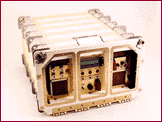


Objectives
The objective of the ASTROCULTURETM experiment was to determine if wheat plants, a commercially important crop species, would complete their life cycle in microgravity if grown in a plant chamber that provided a high level of control of the critically important environmental variables.
Shuttle-Mir Missions Approach Results
A replacement board was delivered to Mir and installed without any problem. The flight unit was restarted and functioned nominally for approximately 2 hours and then shut down. After approximately another 2 hours the flight unit restarted. It was decided that this malfunction most likely was due to the internal temperature in the flight unit (not in the plant chamber) was reaching a level that activated the thermal cut-off switch and opened the power circuit to the flight unit. After several such cycles, it was decided to deactivate the flight unit and terminate the experiment.
Earth Benefits Publications Principal Investigators Co-Investigators![]()
NASA-7
Wheat seeds were planted prior to launch. Following the transfer of the astroculture hardware from the Shuttle, STS-89, to the Mir, the experiment was activated. On activation of the ASTROCULTURETM (ASC-7) flight unit, nutrient solution was transferred from the storage reservoir to the root material for initiating germination of the wheat seeds. During the subsequent growing period of 70 to 80 days, the environmental data recorded by the ASC-7 computer were downlinked to ground controllers. Periodically, video records were to have been made using the on-board camcorder attached to the video camera in the ASC-7 flight unit. After 70 to 80 days, the crew initiated a preprogrammed sequence of environmental changes in the plant chamber that would result in drying the plant material and thereby preserving it until it was returned on STS-91.
The flight unit was activated after STS-89 undocked from the Mir and functioned nominally for approximately 23.5 hours. At that time, a malfunction error was displayed. It was determined that the CPU board of the computer in the flight unit was not functioning.
Considerable potential exists in the research of plant growth and development in the microgravity environment. Plant research has application in agriculture, industrial, and medical enterprises. For example, research with plants in microgravity offers increased knowledge that could lead to advances from crop production on Earth to fragrances and food flavorings.
None available at this time.
Raymond Bula, Ph.D.
Wisconsin Center for Space Automation and Robotics
Weijia Zhou
![]()
|
|
Curator:
Julie Oliveaux
Responsible NASA Official: John Uri |
Page last updated: 07/16/1999
.gif)